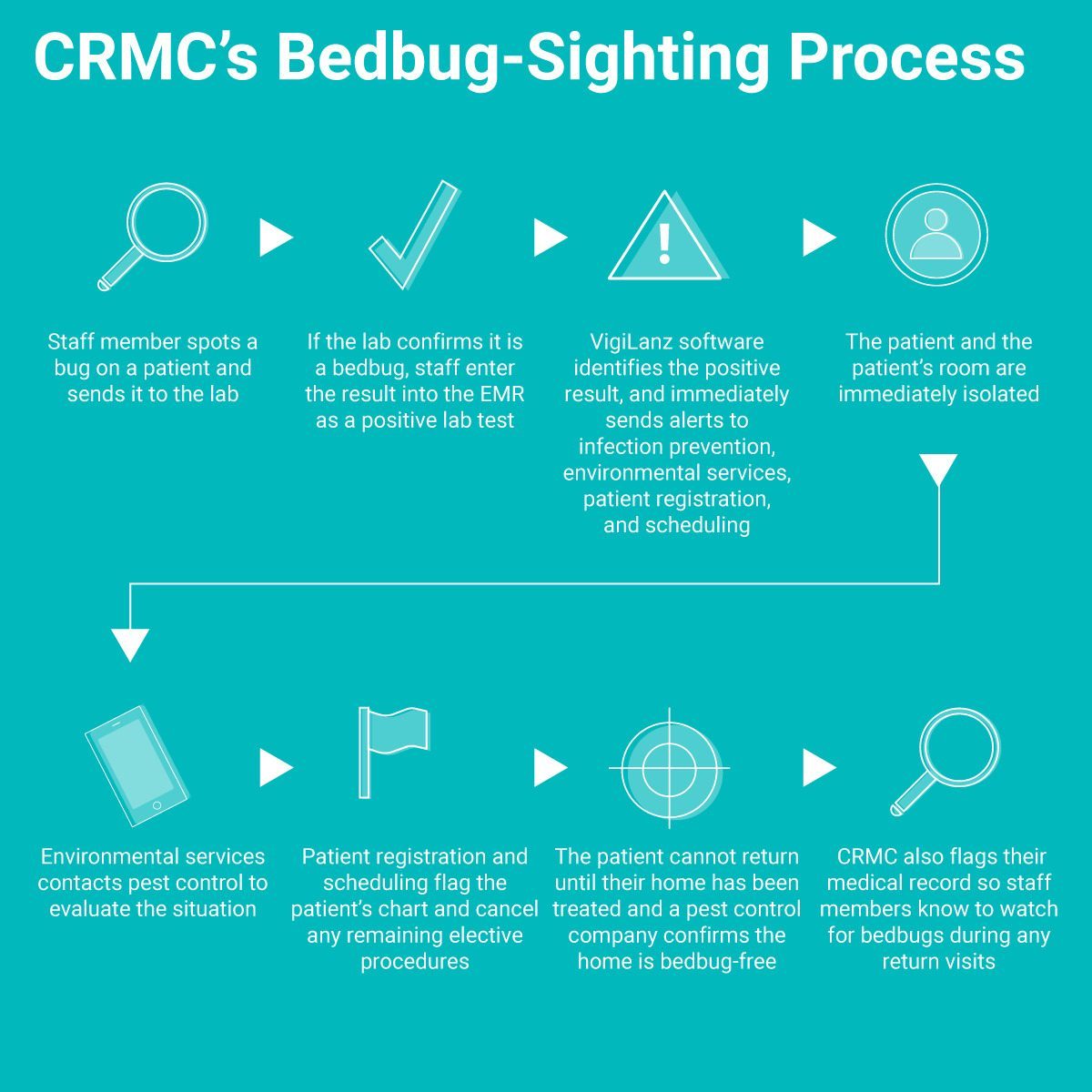Success Stories
Capital Region Medical Center Uses VigiLanz to Prevent Bedbug Infestations
Hospitals across the country are using VigiLanz to complement patient care in many ways. Top uses include pharmacy surveillance, infection prevention, antimicrobial stewardship, and opioid stewardship. But VigiLanz is also completely customizable, so the most innovative and forward-thinking hospitals are using it to create new and unique rules and interventions that lead to optimal patient care. Capital Region Medical Center is one of them.
Customer Profile
Capital Region Medical Center (CRMC), a 100-bed facility in Jefferson City, Missouri, is committed to providing superior patient care, and its safety and quality performance reflects that mission. The hospital, which provides the full spectrum of patient services, is the only one in the area to have received the Missouri Quality Award twice. The Joint Commission has also recognized CRMC as a top performer on quality metrics.
Challenge
An important aspect of providing high quality patient care is fostering a bedbug-free environment. But all hospitals—even those like CRMC that adhere to the highest cleanliness standards—can struggle to keep these pests at bay.
That’s because for most hospitals, bedbugs represent an external challenge, rather than an internal one. Many patients unknowingly bring bedbugs into facilities from the outside, and once the pests gain admittance, they quickly infiltrate the system.
Addressing these infestations can cost hospitals a significant amount of money. A March 2019 study of a 937-bed hospital in Cleveland, Ohio, found that during a one-year period, the hospital had 180 bedbug infestations. Costs were between $125 and $1,050 per infestation, with total costs for the year totaling $22,844 for the ED and $55,915 for the hospital.
While bedbug bites are generally not considered a health hazard, the itchy, red welts can lead to infections if patients scratch them. In hospitals, where there is a higher likelihood of catching MRSA, this is particularly problematic. Bedbug infestations also drive down patient satisfaction, which can lead to lower revenue for hospitals participating in value-based payment models.
Solution
In January 2017, CRMC implemented VigiLanz to support its pharmacy surveillance and infection prevention initiatives. Immediately, the value it provided became clear—and the healthcare providers’ use of the clinical surveillance platform has continually led to higher quality care and reduced costs (see sidebar).
But as CRMC was exploring the VigiLanz platform that January, they recognized there was much more they could be doing with it. “Since the software is completely customizable, we knew we could create new rules and alerts based on our needs and initiatives,” said Valerie Lyon, RN, AA, AS, BSN, CIC, Infection Preventionist at CRMC. “That led me to begin considering how we could use it to curb bedbugs.”
Less than one month after implementing VigiLanz, Lyon’s curiosity and innovative idea resulted in the rollout of a new protocol around bedbug-sightings at CRMC.
“The whole process was built around VigiLanz’s ability to automatically identify that lab result as soon as it is available, and immediately send an alert and email notification,” said Lyon.
CRMC is also using VigiLanz to address environmental bedbug sightings (when a bedbug is spotted but can’t be tied back to a specific patient). In this case, healthcare providers enter the bedbug information into the EMR as a lab for a “dummy patient.” If the lab determines that it is in fact a bedbug, VigiLanz automatically issues alerts and sends emails to the appropriate parties.
Outcomes
CRMC’s bedbug identification process is helping to prevent infestations, control costs, and increase efficiency, said Lyon. Since healthcare providers know much more quickly if there has been a potential bedbug sighting, and they are alerted as soon as a bedbug is confirmed, it’s much easier to limit the movement of these patients through the facility.
This reduces the number of rooms that need pest control treatment, said Lyon, noting that prior to implementing the new process, CRMC regularly performed pest control treatments in multiple rooms and procedural areas.
Since implementing VigiLanz in 2017, the average number of bedbug alerts issued annually has been 14, and CRMC has experienced zero infestations.
“The rules we created enable us to be proactive rather than reactive,” said Lyon. “The real-time alerts help us respond the same day we receive a bed bug alert, which mitigates any risk of a bedbug infestation.”
To learn more about how VigiLanz helps hospitals improve their patient safety and clinical surveillance, contact us today.
VigiLanz Helps Sharp HealthCare Identify Patients for Clinical Trials
Hear how the Sharp Center for Research is using VigiLanz Clinical Trial Solution to speed up the screening process and meet targeted enrollment windows.
Cincinnati Children’s Uses VigiLanz to Identify Patients with Penicillin Allergies
Learn how VigiLanz helped Cincinnati Children’s Hospital Medical Center get ahead of penicillin allergies.

